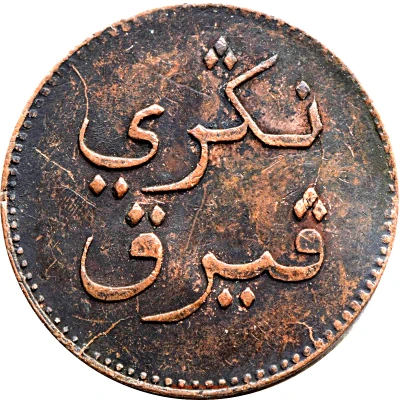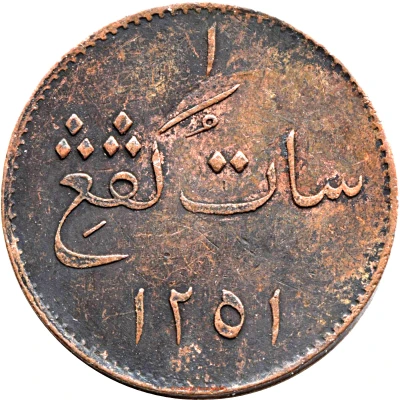


© Joseph Kunnappally
1 Keping Perak
1251 (1836) year| Copper | 2.17 g | 21 mm |
| Issuer | British East Indies |
|---|---|
| Type | Token |
| Year | 1251 (1836) |
| Calendar | Islamic (Hijri) |
| Value | 1 Keping (1⁄400) |
| Currency | Perak - Keping |
| Composition | Copper |
| Weight | 2.17 g |
| Diameter | 21 mm |
| Shape | Round |
| Orientation | Coin alignment ↑↓ |
| Demonetized | Yes |
| Updated | 2024-10-04 |
| Numista | N#135443 |
|---|---|
| Rarity index | 92% |
Reverse
Arabic inscription with denomination at top and date at bottom using eastern Arabic numeral. Beads around border
Script: Arabic
Lettering:
١
سات كڤڠ
۱۲٥۱
Unabridged legend:
1
Satu keping
1251
Translation:
One keping
AH 1251
Edge
Plain
Comment
These coins were not official currency of any state. They were first issued in the early 1800s by British merchants at Singapore, to alleviate base coin shortage, before spreading to various parts of the Malay Archipelago. To circumvent confiscation attempts by colonial authorities (particularly the Dutch), British merchants use inscriptions that refer to locations that are vague, fictitious, or unaffiliated to Europeans. In this manner, legally it could not be argued that the tokens were intended for circulation in colonial territories.See Singh (1986:445-449) for details.
Interesting fact
The A Token 1 Keping (Perak) 1251 (1836) coin from the British East Indies is interesting because it was made of copper, which was a common material used for coins in the 19th century, but it weighs only 2.17 grams, making it one of the lightest coins of its time.